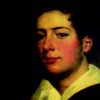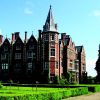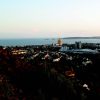Pascoe St Leger Grenfell is memorialised in Adelaide in one of the busiest and most popular city streets.
The committee of twelve distributing honours paired him with Raikes Currie, reasoning they were two venerable churchmen who had more than generously committed monies to the establishment of an Anglican presence in the colony. Grenfell and Currie were both inaugural members and subscribers to the South Australian Church Society and members of the Society for the Propagation of the Gospel in Foreign Parts and the Society for Promoting Christian Knowledge.
Contrary to some contemporary sources, Grenfell Street in Adelaide is not named after Pascoe St Leger Grenfell’s father, Pascoe Grenfell MP, although one could be excused for thinking so because of his significance in the House of Commons in the early-nineteenth century.
The Grenfell dynasty at the time of colonisation in South Australia presided over an extremely rich copper mining and smelting venture in the Swansea area in South Wales. Pascoe St Leger Grenfell ran this enterprise for the better part of his working life. He was revered by the hundreds of his employees and their families for whom he provided a living, and indeed his most outstanding contribution to society was his commitment to the education of their children and the other children living in the Swansea area.
The strongest indication that the street in Adelaide is named after Pascoe St Leger Grenfell can be interpreted from the brief of the committee for the Society for the Propagation of the Gospel in Foreign Parts. This organisation was formed in response to a request from Anglicans among the intending colonists and was consistent with Anglican missionary activity in South Asia and the Pacific.
By mid-1835 the ideologues behind the South Australia scheme and the commissioners had softened the harder lines of Wakefield’s colonisation template for want of sufficient monetary subscriptions. Both Currie and Grenfell stepped into the breach and through their respective banking houses saved the day.
To appreciate the manner in which Grenfell and Currie were drawn into proceedings once the commissioners of the South Australian Colonization Commission had been appointed, we are indebted to the personal diary of John Brown, the newly appointed Emigration Agent at the time of colonisation. In his diary of 27 August 1835, Brown reports that Grenfell was encouraged to buy four town lots off the Adelaide plan and with Currie promised that their respective banking houses (known as Curries and Co. and Esdaile, Grenfell, Thomas & Co.) could be points of collection for monies paid by intending colonists for preliminary land orders.
With such warm appreciation from some of the colonists, Pascoe St Leger Grenfell began to take a closer interest in the project. He subsequently decided to give financial but provisional commitment by donating sufficient monies for a ‘town acre’ on which to build the first church, Holy Trinity, in North Terrace, Adelaide.
Colonel William Light was given the privilege of making the choice and settled on Town Acre No. 9 on North Terrace, the point at which all new settlers coming from Port Adelaide first stepped into his beautifully explicated Adelaide plan. In the first years of the colony, access to the city of Adelaide was always from the north side of the Torrens, from the point where it now meets the Southwark Brewery at the top of the Port Road and then along the southern boundary of what is now North Adelaide Golf Course.
Grenfell also donated monies to the Anglican community for an accompanying country section at Trinity Gardens, near Magill, which explains why St George’s Anglican Church in Magill is so situated and was consecrated so early in the colony’s history. Some of this land near Magill was set aside as the Glebe, but Grenfell stipulated that should there be any income derived from it only a proportion, up to a specified amount, was to be for the church and the remainder was to go to named charities.
Pascoe St Leger Grenfell, Justice of the Peace and Deputy Lieutenant of the County of Glamorgan, was born on 5 November 1798 and baptised at St Martin-in-the-Field, in Westminster, London.
He was the first child of Pascoe Grenfell MP’s second marriage and was followed by six younger sisters and finally one younger brother. The young Grenfells were imbued with a strength of religious belief, a commitment to philanthropy and a heightened sense of responsibility towards others. His father’s first marriage to a cousin Charlotte Grenfield had issue, a girl followed by two boys. All together Pascoe St Leger Grenfell’s father sired eleven children over two marriages.
When Pascoe Grenfell, the elder, was well into his 60s, he began to draw his sons, especially Pascoe St Leger, into his business activities. Their mines in Swansea became one of the great metallurgical centres of Europe in the nineteenth century and they commissioned their own line of ships, which plied between Swansea and the industrial north at Deeside and Liverpool.
In the 1830s, as part of his grooming for the banking and insurance sector, Pascoe St Leger Grenfell took up residence away from the family home at Taplow and in London, where he began to assume more responsibility over his father’s substantial affairs. At this poignant time of electoral change their ilk included the ecclesiastical hierarchy, venture capitalists, bankers, members of parliament and some of the literati. At the Reform Club, where Grenfell was a member, matters such as the great colonial experiment in Southern Australia were no doubt topics of conversation over lunch, following the Club’s inauguration in 1836.
With the passing of his father in 1838, Pascoe St Leger repaired to Swansea, where the huge family copper mining enterprise was gaining momentum. Such had been the growth between 1800 and 1850 that the population in and around Swansea swelled from 6,000 to more than 40,000. By the 1840s Pascoe St Leger Grenfell had more than 800 men in his employ. Swansea had become a world centre and focal point for copper smelting, and scores of ships gathered in the ‘roadsteads’ off Swansea. With an increased population the Grenfell family was responsible for investment in the much-needed infrastructure associated with railway transport and the Swansea docks.
For someone who had been raised in a stately mansion and who had the benefit of a privileged education at Eton, and time in France as a boy where he was tutored in French and enjoyed a verbal exchange with Napoleon, Pascoe St Leger Grenfell not only provided model housing for his workers, but also he refused to desert his working-class support by living in the fashionable Swansea West. Instead he chose to build a family home, close to the smelting works, downwind from any pollution which belched incessantly from as many as 600 industrial chimneys. In all his time at Swansea there were no strikes or lockouts.
Pascoe St Leger Grenfell’s first wife, Catherine Ann Du Pre, was the eldest daughter of James Du Pre MP of Wilton Park in Buckinghamshire and the granddaughter of Josias Du Pre, an earlier Governor of Madras. The couple married in 1824 and Catherine bore Pascoe St Leger four sons and five daughters before passing prematurely in 1845. In 1847, Pascoe St Leger Grenfell took a second wife, Penelope Frances Madan, the third daughter of the late Reverend Spencer Madan D.D. who had been the Dean of Chichester. Penelope was a devout woman of great compassion who supported her husband’s philanthropic and steadfast commitment to the parish at Kilvey, where he ran the Sunday School for more than thirty years. The couple worked tirelessly for the church and the local community.
He built three ‘ragged’ schools (charities for the free education of destitute children) in the Swansea area, All Saints Church in Kilvey, a concert hall and other buildings including model homes for workers in the burgeoning industrial centre.
Pascoe St Leger Grenfell followed his father’s liberal sentiments and spoke with feeling and conviction on the need for free trade whenever asked. However, he did not seek political office, preferring instead to confine himself to shire politics in Swansea. In business he successfully administered the family’s expanding shipping line and several directorships in the new and exciting railway companies that were springing up all over Britain.
His strongest patronage was always reserved for his Christian God, and as a member of the parent body of the London Missionary Society he travelled the country on its behalf. With central affiliation and a London presence in the Society for the Propagation of the Gospel in Foreign Parts and in the Society for Promoting Christian Knowledge, it came as no surprise that he too was to become a member of the South Australian Church Society and a patron of the Anglican Church in Adelaide.
On 27 March 1879 he died at the home of his daughter, Mrs Katherine Thornton, in Nottingham. He was interred on 2 April in the family vault in the old churchyard of his childhood home of Taplow Court in Buckinghamshire.







Comments